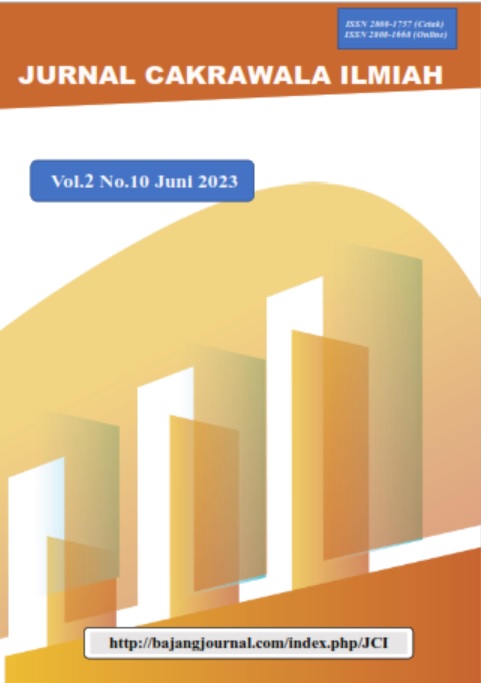EXPLORING THE RELATIONSHIP BETWEEN WORD KNOWLEDGE AND EFFECTIVE COMMUNICATION
DOI:
https://doi.org/10.53625/jcijurnalcakrawalailmiah.v2i10.5847Keywords:
Word knowledge, English education, effective communicationAbstract
Many studies have explored strategies to master word knowledge and communication in English as a Foreign Language (EFL), but only a few have yielded satisfying findings regarding the correlation between these two domains. This research aimed to investigate the significant correlation between English word knowledge proficiency and communication skills. An Ex Post Facto research design was employed, involving a sample of 40 students selected from a total of 150 students at SMK PGRI 3 Badung. Tests were administered to measure the variables, and the data were analyzed using SPSS 25.0 to determine the correlation between English word knowledge mastery and communication skills. The results indicated a significant positive correlation between students' English word knowledge proficiency and their communication skills. These findings imply that a higher level of word knowledge mastery is associated with enhanced communication abilities, highlighting the importance of word knowledge acquisition in facilitating effective communication.
References
Alqahtani, M. (2015). The Importance of Word knowledge in Language Learning and How to be Taught. Saudi Arabia.
Aristini, N., Prawati, A., and Desi, M. (2017). The Correlation between the Word knowledge Mastery and the Speaking Ability in Describing People by the Second Year Students of SMPN 12 Bintan. Indonesia.
Ary, et. al. (2010). Introduction to Research in Education (Eighth Edition). USA: The Wadsworth Cengage Learning.
Bailey, M. Katheleen. (2003). Speaking In David Nunan (ed). Practical English Language Teaching. Singapore: McGrow-hill education
Brown, H. D. (2004). Language Assessment: Principles and Classroom Practices. United States: Longman.
Brownell, J. (2002). Listening: Attitudes, principles, and Skills (2nd Edition). Boston: Allynand Bacon.
Byrnes, H. (1984). The Role of Listening Comprehension: A Theoretical Base. Foreign Language Annals, 17, 317-29
Chastain, K. (1998). Developing Second Language Skills (2nd Ed.). Chicago: Harcourt Brace Publishers.
Cohen, et. al. (2005). Research Method in Education (Fifth Edition). New York: Routledge.
Cooper, D.R. and Schindler, P.S. (2001). Business Research Methods. USA: McgrawHill College.
Cresswell, J. W. (2008). Educational Research Planning Conducting, amd Evaluating Quantitative and Qualitative Research. New Jersey: Pearson Hall.
Dance. (1986). Speech Communication: Concepts and Behavior. New York: Holt, Rinehart and Winston.
Erwadi, (2004). A Study on Effectiveness of Using Picture in Teaching Speaking at SLPTN 6 Pekanbaru. Pekanbaru: Unpublished Thesis.
Fernández, M. (2013). Communication concept and components of the communicative process. EF Sports digital magazine. Recovered from: efdeportes.com
Franscy. (2006). The Correlation Between Word knowledge Mastery and Pronunciation Ability with Speaking Ability. Indonesia.
Hatch, E. and Cheryl, B. (1995). Word knowledge Semantics and Language Education. Cambridge University Pers.
Idris, R. (2010). Pemeriksaan Ciri-ciri Psikometrik dan Pembentukan Penanda Aras Pentadbiran Kemahiran Genarik. Unpublished Thesis, Doktor Falsafah, Fakulti Pendidikan, Universiti Kebangsaan Malaysia.
Iksan, H. J. and Zakaria, E. Communication Skills Among University Students. Malaysia.
Kothari, C.K. (2004). Research Methodology Methods and Techniques (second revise edition). New Age International (p) LtdI.
Kraus, R. (2002). The Psychology of Verbal Communication. Colombia University.
Qureshi, I. A. (2015). The Importance of Speaking Skills for EFL Learner. Pakistan.
Richards, J. C. (2008). Teaching Listening and Speaking From Theoryto Practice. United States.
Richards, J. C., and Renandya, W. A. (2002). Methodology in Language Teaching (An Anthology of Current Practice). New York Cambridge University Press.
Seiler, W. J., & Beall, M. L. (2005). Communication: Making connections (6th. ed). Boston: Allyn & Bacon.
Smith, J. (1996). Empowering People: How to Bring Out the Best in Your Workforce. London: Kogan Page
Thonrbury, S. (2005). How to Teach Speaking. Harlow: England Longman.
Tumtimtong, W. (1993). The Problem of Translating Communicative Needs into Course Design and Implementation. Paper presented at the SEAMED Regional Language Centre Regional Seminar: Singapore.
Ur, Penny. (1996). A Course in Language Teaching, Practice, and Theory. Cambridge: University Press
Downloads
Published
How to Cite
Issue
Section
License
Copyright (c) 2023 Jurnal Cakrawala Ilmiah

This work is licensed under a Creative Commons Attribution-NonCommercial 4.0 International License.
















